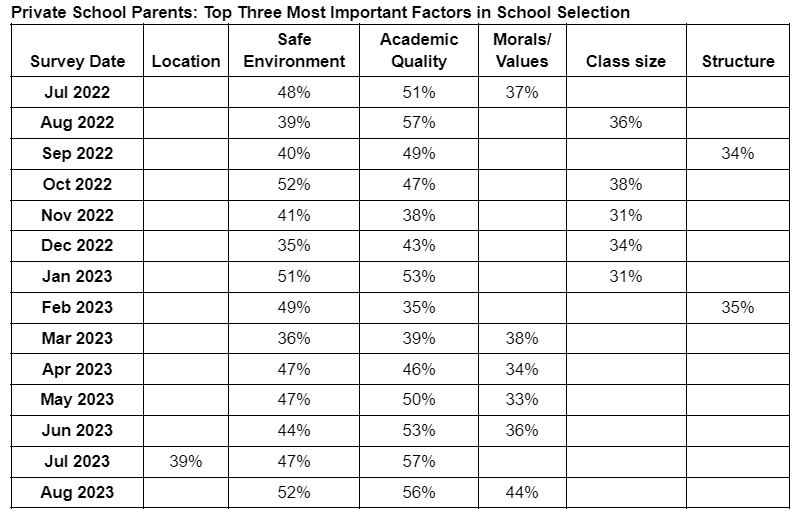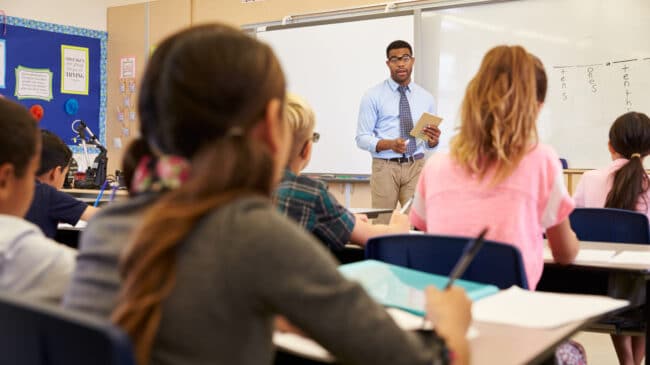Conventional thinking, supported by two decades of Gallup polling, indicates that most parents are satisfied with the local public schools their kids attend. Even though support for public schools has declined among most Americans since the COVID-19 pandemic, a 2022 Gallup survey found that 80% of parents were satisfied with their oldest child’s local public school, continuing pre-pandemic trends.
Gallup’s findings are not unusual. Matt Barnum reported at Chalkbeat that at least four recent surveys support this finding. While Gallup’s survey doesn’t examine why most families are satisfied with their local school, monthly nationwide surveys by EdChoice, a nonprofit, nonpartisan organization that supports school choice, since July 2022, have asked parents this very question. EdChoice’s results reveal that parental satisfaction with their local public school is primarily based on convenience and doesn’t necessarily preclude openness to other educational options, especially if those alternatives can be less costly and more readily available.
About 50% or more of respondents with children in traditional public schools indicated to EdChoice that “location” was the most important factor in school selection each month. The second most commonly cited reason in school selection for traditional public school parents was “affordability” or “cost.”

Location is extremely important to most traditional public school families because where you live determines students’ public school assignments. Living on the wrong side of a school boundary can significantly increase or limit the educational opportunities available to children, such as the availability of Advanced Placement (AP) courses, safety, class sizes, sports, extracurricular activities, and even social connections.
Many families are willing to pay high housing costs to guarantee access to highly-ranked public schools. The U.S. Senate Joint Economic Committee in 2019 reported that the median home prices in zip codes associated with highly ranked public schools were quadruple the cost of the median home prices in poorly ranked public schools. That same year, the National Center for Education Statistics reported that nearly 9% of families moved to specific neighborhoods to guarantee access to certain public schools.
Accordingly, it’s no surprise that cost or affordability are at the top of parents’ minds when they choose their kids’ public schools. Some families even weigh the costs of more expensive housing against the long-term costs of private school tuition in their calculus.
For instance, in his book A Fine Line, Tim DeRoche, founder of Available to All, a nonpartisan group that aims to increase access to the best public schools, reported that Brian Speck, a father of two, chose to pay an extra $250,000 for a home to ensure that his children were guaranteed access to a highly rated elementary school in Chicago.
Since “private school [tuition] in Chicago can run up to $40,000 a year,” Speck realized it was more affordable to pay $250,000 more for housing in the long run, DeRoche writes.
The inextricable tie between housing and schooling explains why location and cost are critical factors in school selection for many public school families. It also explains why families are often satisfied with their local public schools. Many families don’t have options that compare to the cost and convenience. Consequently, these factors play an outsized role in school selection, especially compared to those prioritized by families sending their children to private schools.
The EdChoice surveys found that parents who pay for private school tuition, who rarely or never ranked “location” or “cost/affordability” in their top three most important factors in school selection, consistently prioritized “academic quality” and “safe environment” instead. Moreover, private school parents tend to prioritize a wider array of factors in school selection than their counterparts using traditional public schools, such as morals/values or class sizes.

This data illustrates residential assignments’ outsized role in school selection for many families. Since education funding is not very portable in most states and few have robust open enrollment policies, traditional public schools are often the only option available to many families. However, if more states expanded their education marketplaces, more families could afford to prioritize other factors in school selection that aren’t limited by their incomes.
While 2022 Gallup polling showed that only one in five parents are dissatisfied with their oldest child’s public school, EdChoice’s polling between July 2022 and August 2023 indicated that the percentage of dissatisfied families could be higher. EdChoice found that 38%-44% of parents indicated that they would absolutely keep their children enrolled in traditional public schools even if cost and transportation didn’t matter. More than half of parents said they would consider non-district schools given the opportunity, such as private, charter, or home schools. Notably, nearly one in 10 respondents stated that they would homeschool their children.
If parents were truly satisfied with their traditional public schools, why do so many say they would consider transferring to other school sectors if transportation or costs (one of the most important factors in school selection for public school parents) didn’t matter? Parents may be less satisfied than they appear at first glance of the Gallup surveys. Schools that satisfy their stakeholders–students and their parents–should be able to retain them even if families are given other education options.
While some families like traditional public schools and wouldn’t switch to another education model even if they could, many families are open to a more porous education experience where students use one or more education providers of their choice. Universal private and public school choice programs and the weakened residential assignment are key policy reforms necessary to make robust education marketplaces.
Some policymakers are keenly aware of the appetite for school choice among parents. In 2023, 14 states adopted a total of 16 private or public school choice policies, greatly expanding education options for students in those states. Today, 16 states have statewide cross-district open enrollment policies that let students attend any traditional public school with available seats, while nine states have universal or near-universal private school scholarships.
These programs can provide significant education alternatives to many students that aren’t based on where students can afford to live. For example, in Arizona, approximately 115,000 students used K-12 open enrollment, 240,000 students used charter schools, and nearly 10,000 students used education savings accounts during the 2021-22 school year. This means that 32% of publicly funded Arizona students attended the school of their choice.
A robust education marketplace like Arizona’s has much to offer parents and students. As the importance of residential assignment declines, families can prioritize other factors in school selection without breaking the bank. It also makes school selection more fair since less affluent families who can’t afford to live in expensive neighborhoods still have access to good public schools. But most importantly, with open enrollment, students can attend schools that are the right fit.

